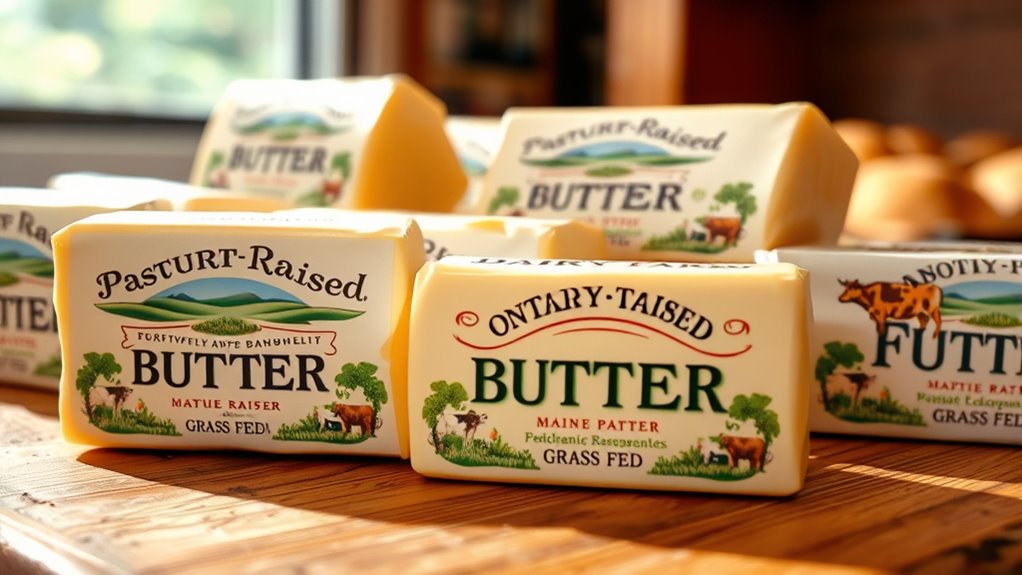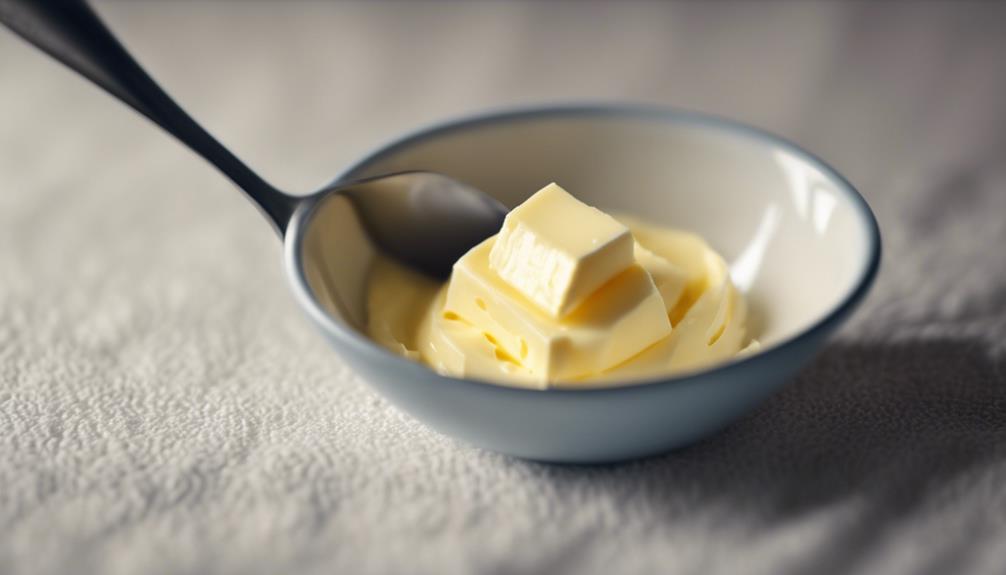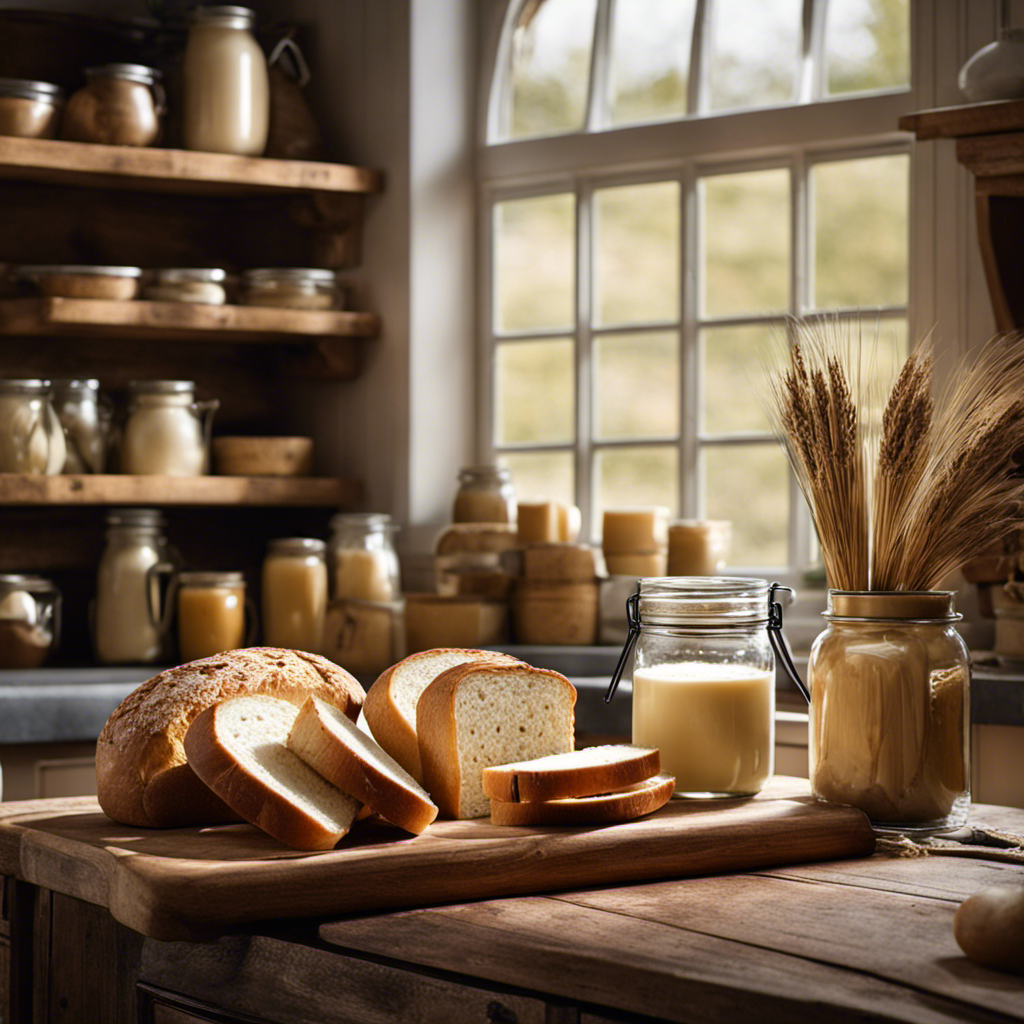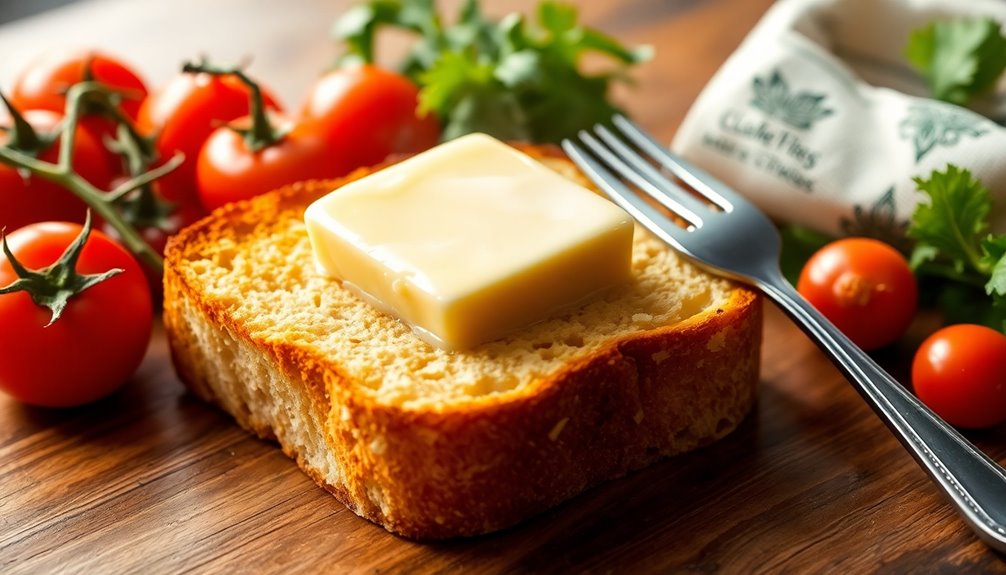Understanding butter labels like “pasture-raised” and “grass-fed” helps you identify quality and ethical practices. “Pasture-raised” means cows graze outdoors, which improves flavor and nutrition, while “grass-fed” emphasizes their natural diet, boosting omega-3s and flavor. Labels such as “organic,” “certified humane,” or “hormone-free” reveal farming standards and animal welfare. Recognizing these terms guarantees you choose better products. If you want to know more about what each label truly means, keep exploring the details behind each claim.
Key Takeaways
- “Pasture-Raised” indicates cows graze outdoors most of their lives, with grazing duration and rotation affecting butter quality.
- “Grass-Fed” means cows eat fresh pasture, enhancing flavor, omega-3 content, and nutrient richness in butter.
- Organic labels ensure cows are fed organic feed and have pasture access, avoiding synthetic inputs and promoting sustainability.
- Certifications like “Certified Humane” verify ethical farming practices, often leading to higher-quality, flavorful butter.
- “Artisanal” or “craft” labels can be marketing tools; scrutinize labels and production details for genuine authenticity.
Understanding “Pasture-Raised” and Its Implications
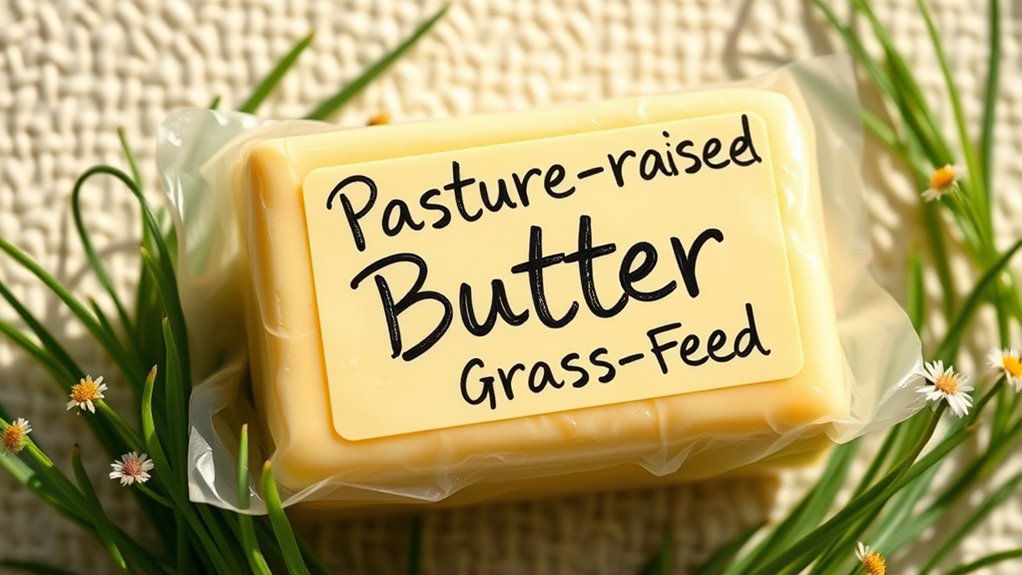
While the term “pasture-raised” may seem straightforward, it can be misleading without proper context. Dairy farm practices and pasture management are key to understanding this label. When a product is labeled “pasture-raised,” it generally means cows spend most of their lives grazing outdoors on pasture. However, standards vary, and some farms may only give cows access to pasture for part of the year or for limited hours. Good pasture management involves rotating grazing areas to prevent overgrazing and ensure cows have access to fresh forage. This approach promotes healthier animals and improves milk quality. The duration of pasture access and grazing practices are critical factors to consider when evaluating the authenticity of the label. By understanding how dairy farms practice pasture management, you can better assess whether a “pasture-raised” label truly reflects ethical and sustainable farming.
The Meaning Behind “Grass-Fed” and Its Impact on Butter Quality
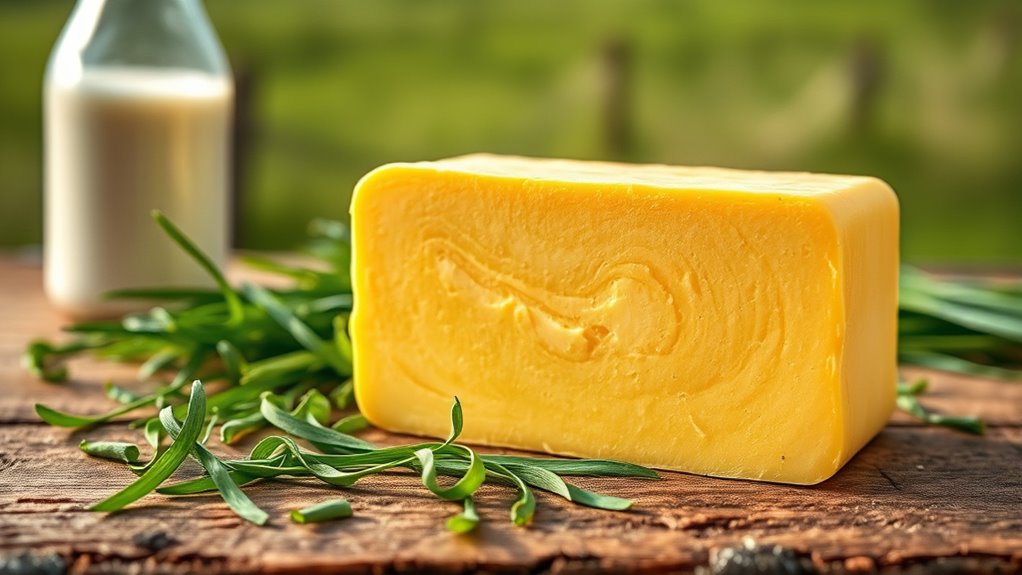
What does “grass-fed” really mean when it comes to butter, and how does it influence its quality? When dairy farmers raise cows on a grass-fed diet, the resulting butter often has a richer, more complex flavor. Grazing on fresh pasture allows cows to consume a natural variety of grasses, which enhances the butter’s taste and aroma. This diet also impacts the butter’s nutritional profile, typically increasing omega-3 fatty acids and antioxidants. Because grass-fed cows graze in open fields, the butter produced tends to be fresher and more vibrant. Overall, “grass-fed” indicates a farming practice that emphasizes natural diets and humane treatment, which directly affects the butter’s flavor, quality, and nutritional value.
What “Organic” Labels Signify for Butter Consumers
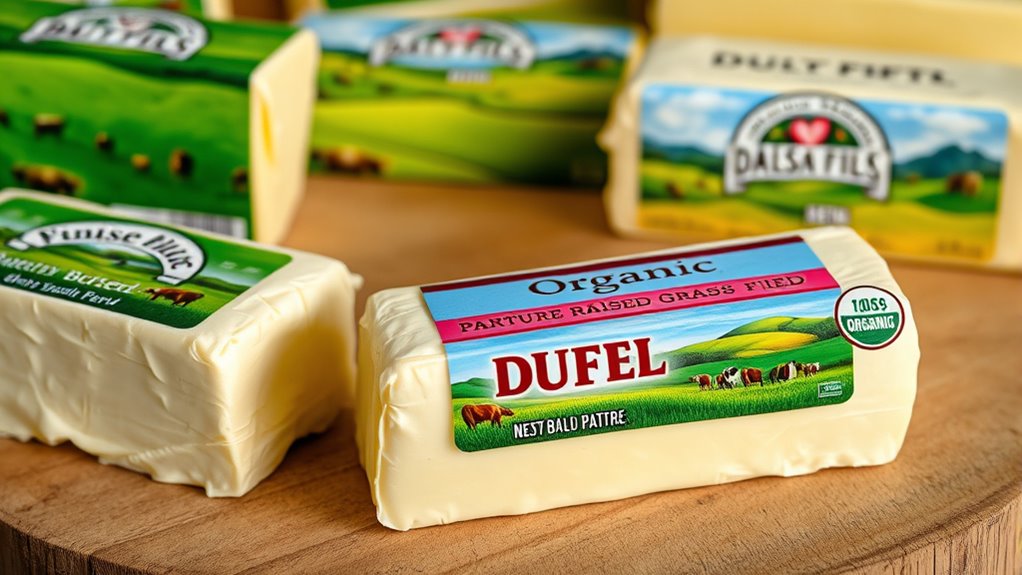
When you see the “organic” label on butter, it signals that the product meets strict standards set by organic certification agencies. This means the dairy farming practices prioritize animal welfare, avoiding synthetic hormones and antibiotics. The cows are typically fed organic feed and have access to pasture, supporting healthier and more natural conditions. Organic butter also often comes with commitments to sustainable packaging, reducing environmental impact. You can feel confident that you’re choosing a product that aligns with environmentally friendly practices and supports sustainable agriculture. These standards ensure fewer chemical residues and promote biodiversity. By opting for organic butter, you’re supporting dairy farmers committed to eco-conscious practices and high-quality, responsibly produced dairy. Ethical Hacking standards in farming emphasize transparency and accountability to ensure compliance with these practices.
Differentiating Between “Farm-Fresh” and “Natural” Butter Labels
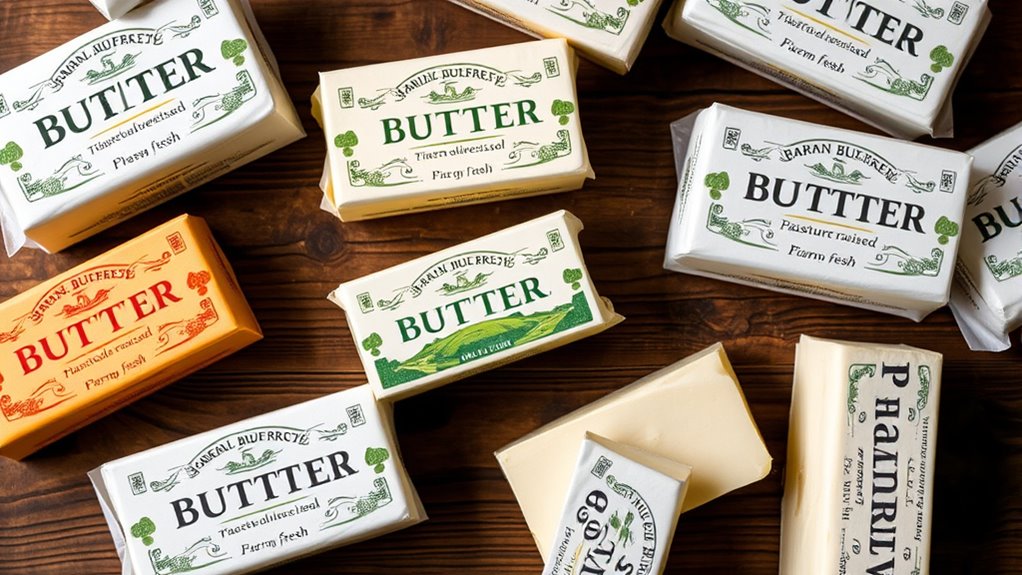
Understanding the difference between “farm-fresh” and “natural” butter labels can help you make more informed choices at the store. “Farm-fresh” suggests a direct farm-to-table process, emphasizing minimal processing and freshness, often aligning with dairy ethics that prioritize animal welfare and local sourcing. In contrast, “natural” is a broader term that generally indicates the absence of artificial additives or preservatives but doesn’t guarantee freshness or specific farming practices. “Farm-fresh” labels imply a closer connection to ethical dairy farming, while “natural” focuses on the product’s composition. Knowing these distinctions helps you support ethical dairy practices and select butter that aligns with your values, whether you prioritize freshness, transparency, or ethical farm-to-table sourcing.
The Significance of “Non-GMO” and “Hormone-Free” Claims
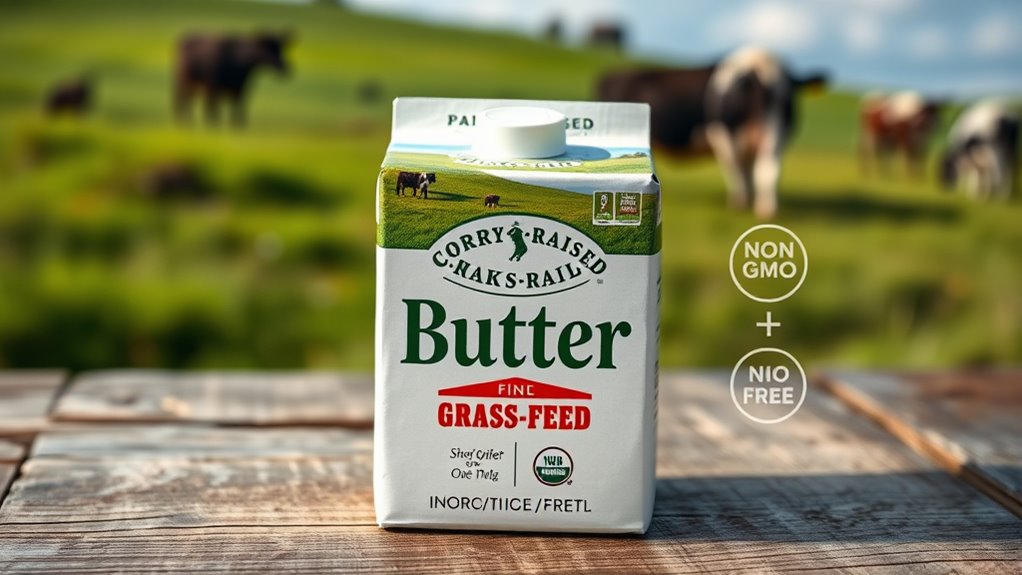
Have you ever noticed “Non-GMO” and “Hormone-Free” labels on butter cartons and wondered why they matter? These claims reflect dairy farming practices that prioritize natural methods and minimize chemical interventions. “Non-GMO” indicates the cows aren’t fed genetically modified feed, which some consumers believe affects the quality and safety of the dairy. “Hormone-Free” means no growth hormones are used to increase milk production, aligning with natural farming principles. These labels influence your choice by emphasizing healthier, more transparent practices. Additionally, butter packaging innovations now highlight these claims more prominently, helping you quickly identify products that meet your preferences. Recognizing the significance of “Non-GMO” and “Hormone-Free” labels empowers you to make more informed, health-conscious decisions about the butter you buy.
How “Locally Sourced” Influences Butter Choices
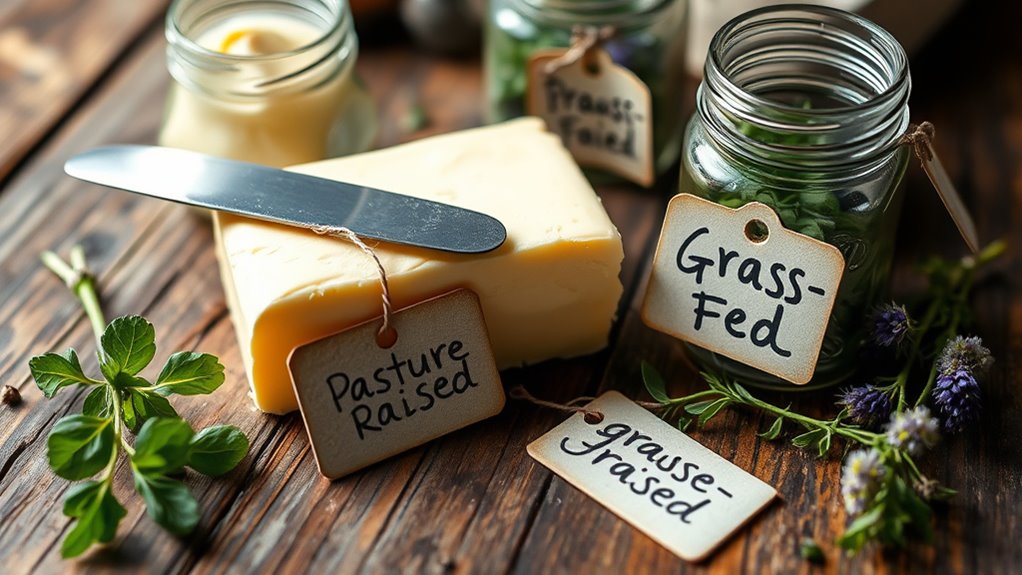
Choosing locally sourced butter can substantially impact both your health and community. When you buy locally, you’re more likely to experience fresh butter with richer, more diverse flavor profiles because it’s less processed and shipped over long distances. This freshness enhances the butter’s taste, making it a better addition to your dishes. Additionally, supporting local producers often means choosing brands that prioritize packaging sustainability, reducing environmental waste. Local farms tend to use eco-friendly packaging options, which minimizes your carbon footprint. By selecting locally sourced butter, you not only enjoy better flavor and freshness but also contribute to a more sustainable food system. Your choice encourages community resilience and promotes environmentally responsible practices.
Clarifying “Unpasteurized” Versus Pasteurized Butter Labels
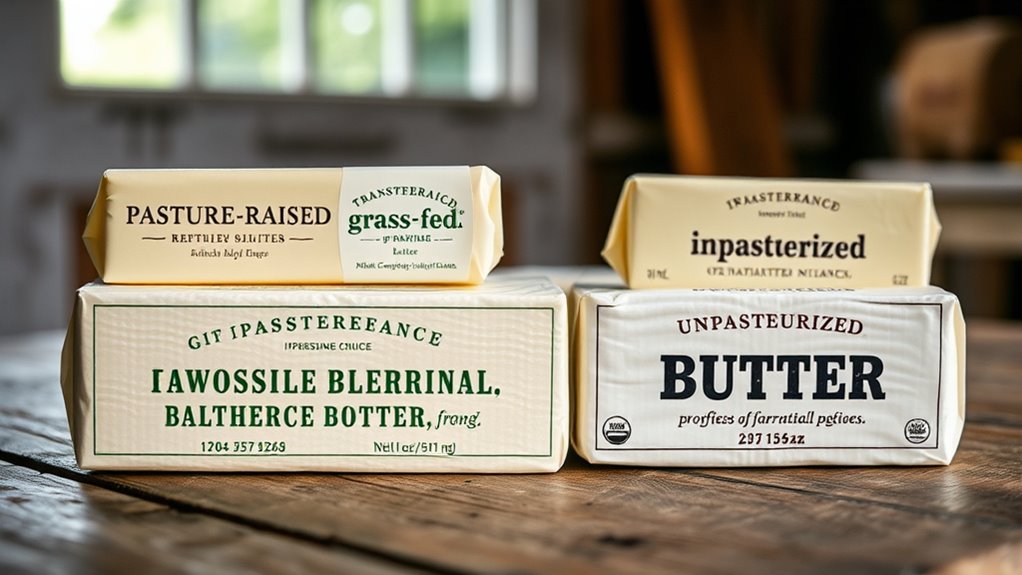
When selecting butter, it’s important to pay attention to its processing methods, particularly whether it’s labeled as unpasteurized or pasteurized. The pasteurization process involves heating the milk to kill harmful bacteria, enhancing dairy safety. Unpasteurized butter, made from raw milk, retains more enzymes and flavors but carries a higher risk of contamination. Pasteurized butter undergoes heating, reducing pathogens and ensuring safety. Here’s a quick comparison:
| Aspect | Unpasteurized Butter | Pasteurized Butter |
|---|---|---|
| Dairy Safety | Higher risk of bacteria | Safer due to heat treatment |
| Flavor Profile | Richer, more complex flavors | Milder, more consistent taste |
| Processing Method | Made from raw milk, no heat treatment | Heated during pasteurization |
Understanding these differences helps you choose butter aligned with your safety and flavor preferences.
The Role of “Certified Humane” in Butter Production
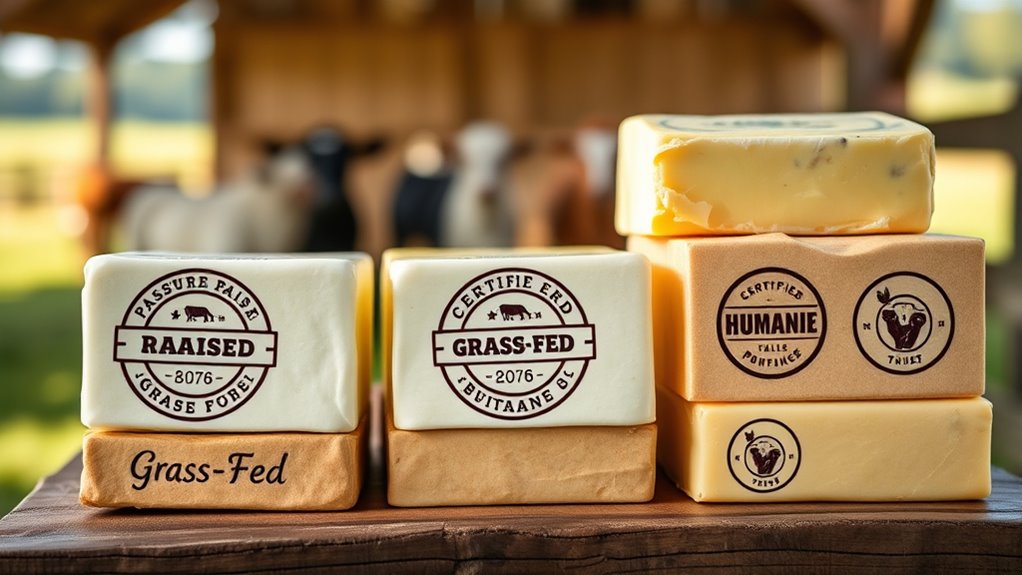
When you see the “Certified Humane” label on butter, it means the animals are treated according to strict welfare standards. The certification process involves regular inspections and adherence to specific guidelines, ensuring transparency. This focus on humane treatment often results in butter with better flavor and quality, benefiting both animals and consumers. Global intelligence plays a role in monitoring and enforcing these standards to maintain credibility and safety.
Humane Animal Treatment Standards
Certified Humane standards play a crucial role in ensuring that animals used in dairy production are treated ethically and compassionately. These standards prioritize animal welfare by setting strict guidelines for living conditions, diet, and handling practices. When you see the Certified Humane label, you’re supporting ethical farming that respects animals’ natural behaviors and needs.
Key aspects include:
- Access to pasture and outdoor spaces, promoting natural movement
- Proper shelter and bedding for comfort and health
- Humane handling practices that minimize stress and injury
Certification Process Overview
Ever wondered how butter gets the “Certified Humane” label? It all starts with strict labeling regulations that assure transparency. Certification agencies, like Humane Farm Animal Care, evaluate farms based on specific animal welfare standards. You’ll find these agencies conduct thorough inspections to verify humane practices, such as proper shelter, proper handling, and access to outdoor space. To earn certification, farms must meet detailed criteria and maintain ongoing compliance through regular audits. This process guarantees that the butter labeled “Certified Humane” truly comes from farms committed to animal welfare. The certification process is designed to protect consumers and promote ethical farming. Additionally, understanding the certification standards can help consumers make informed choices about the products they buy. By understanding how certification agencies enforce these standards, you can confidently choose butter that aligns with your values.
Impact on Product Quality
Have you ever wondered how the certification process influences butter’s overall quality? When a butter is “Certified Humane,” it often means better ingredients and production standards, which directly affect butter flavor. You’ll notice that these products tend to have a richer, more authentic taste. Additionally, the certification can influence packaging design, making it more appealing and trustworthy. Here’s how it impacts quality:
- Ensures higher animal welfare, leading to healthier, more flavorful milk
- Promotes sustainable practices that preserve natural freshness
- Encourages attractive packaging that highlights quality and ethical standards
All these factors combine to elevate your butter experience, giving you confidence in what you’re buying. “Certified Humane” isn’t just a label—it’s a marker of superior product quality.
Common Misconceptions About “Artisanal” and “Craft” Butter
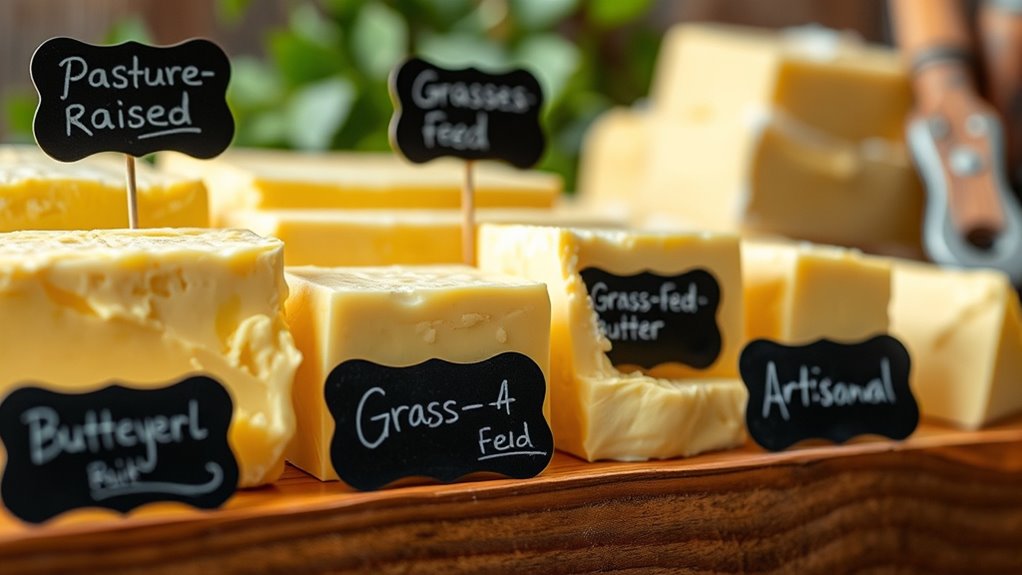
Many products labeled as “artisanal” or “craft” butter may not be as authentic as they seem. You might assume these labels guarantee higher quality or traditional methods, but marketing often blurs that line. Understanding the true origin and standards behind these claims helps you make better choices.
Authenticity vs. Marketing
While the labels “artisanal” and “craft” butter often evoke images of small-batch quality and traditional methods, these terms are frequently used as marketing tools rather than accurate descriptions. They can mislead you into believing the butter has unique flavor profiles or handcrafted quality. Watch out for:
- Packaging design that looks authentic but is mass-produced
- Claims of small-batch production that mask large-scale manufacturing
- Flavor profiles that may be exaggerated or artificially enhanced
These marketing tactics aim to appeal to your desire for authenticity, but they don’t always reflect the true process behind the butter. Be skeptical of labels that rely heavily on aesthetic or vague language—true artisanal quality goes beyond marketing buzzwords.
Quality Standards Confusion
What exactly sets artisanal or craft butter apart from mass-produced varieties? It’s not just marketing buzz—it’s about dairy industry practices and quality standards. Artisanal butter typically involves traditional methods, small-batch production, and fewer additives, which many consumers perceive as better quality. However, the term “craft” can be misleading; some producers use it without adhering to strict standards, leading to confusion. The dairy industry practices vary wildly, and without clear regulation, what qualifies as “artisanal” isn’t always consistent. This fuels misconceptions, making it hard to distinguish genuinely high-quality butter from mass-market products labeled as “craft” or “artisanal.” As a consumer, understanding these nuances helps you make informed choices beyond marketing claims. Additionally, unique and wicked planters demonstrate how diverse standards and practices can influence perceptions of quality in related fields.
Origin and Production Claims
The labels “artisanal” and “craft” often create a false impression of origin and production methods. These terms can suggest small-scale, traditional processes, but that’s not always the case. You might find butter with impressive packaging design that appears handmade, but the actual production could be industrial. To spot genuine artisanal butter, consider:
- Whether the butter’s flavor is complex and nuanced, reflecting traditional techniques
- If the packaging emphasizes transparency or uses rustic, minimalist designs
- The producer’s claims about sourcing and craftsmanship, rather than just marketing hype
- Recognizing that artisanal practices often involve a deliberate focus on creative practice and craftsmanship, which can distinguish authentic products from mass-produced ones.
Tips for Reading Labels and Making Informed Purchases
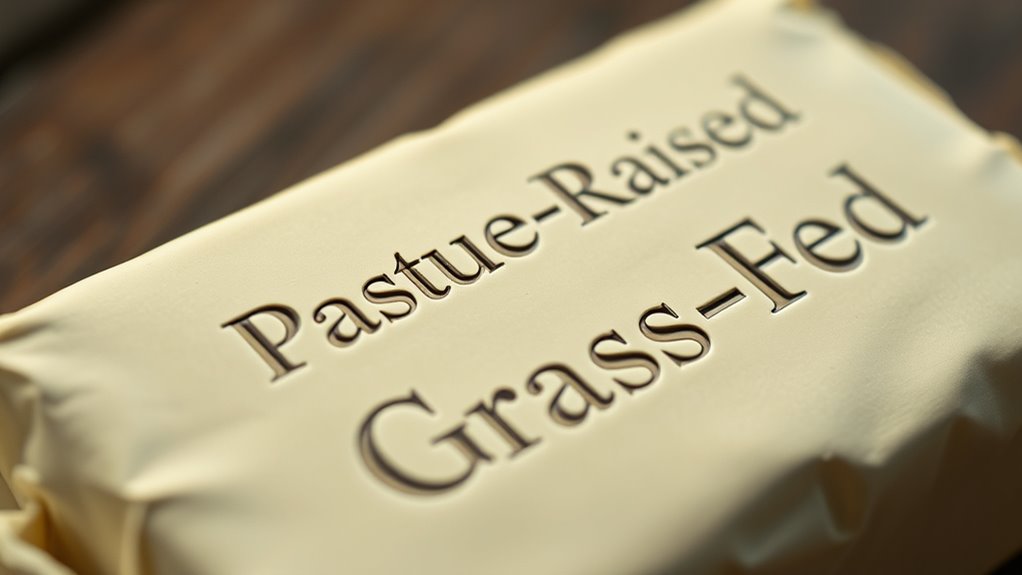
Reading butter labels carefully can help you make smarter choices at the store. Pay attention to butter storage instructions—proper refrigeration guarantees freshness and safety. Check labels for clarity on ingredients and production methods; look for terms like “pasture-raised” or “grass-fed” to understand quality. Be aware of flavor variations, which can differ based on cow diet and processing. If you prefer a richer taste, opt for cultured or European-style butters, often labeled accordingly. Compare packaging dates to select the freshest product. Also, consider the packaging size—buy in amounts you’ll use soon to avoid waste. By reading labels thoroughly, you’ll better understand what you’re buying, ensuring your butter aligns with your flavor preferences and storage needs.
Frequently Asked Questions
How Do “Pasture-Raised” and “Grass-Fed” Labels Differ in Meaning?
You might wonder how “pasture-raised” and “grass-fed” differ in meaning. “Pasture-raised” means dairy cows spend most of their time outdoors on pasture, aligning with dairy farming practices focused on animal welfare. “Grass-fed” typically indicates cows are fed primarily grass, but labeling regulations vary, and it doesn’t always guarantee extensive outdoor access. Understanding these labels helps you make informed choices based on farming practices and regulatory standards.
Can “Organic” Butter Still Contain Additives or Preservatives?
Did you know that about 70% of consumers prefer organic products? Organic butter can still contain additives and preservatives if they’re approved within organic standards. While organic processing methods restrict synthetic ingredients, some natural additives may be employed. Always check labels carefully, as “organic” doesn’t automatically mean additive-free. Organic butter generally undergoes gentler processing, but it’s essential to verify ingredients to guarantee it meets your preferences.
What Does “Unpasteurized” Imply About Butter Safety and Shelf Life?
When you see “unpasteurized” on butter, it means it hasn’t undergone the pasteurization process, which kills harmful bacteria. This can increase your bacteria risk, especially if stored improperly. Unpasteurized butter may have a shorter shelf life because it lacks the extra safety step of heat treatment. If you choose unpasteurized butter, you should handle and store it carefully to minimize health risks and enjoy it sooner.
Are “Locally Sourced” but Non-Organic Butters Better for Health?
Think of choosing butter like picking a trusted friend; local sourcing benefits you with fresher, more transparent ingredients. While non-organic butters might seem tempting, they pose risks like exposure to pesticides and additives. Non-organic butter isn’t inherently harmful, but it may lack the purity and health benefits of organic options. If health matters, prioritize local, organic choices to nourish your body and support your community.
How Reliable Are “Artisanal” and “Craft” Labels in Indicating Quality?
You’re wondering how reliable “artisanal” and “craft” labels are for quality. These labels often signal artisanal authenticity, suggesting careful, traditional methods over mass-produced, commercial goods. However, they can be misleading, as some brands use them for marketing without strict standards. To truly gauge quality, look beyond labels, researching the producer’s practices and reputation, rather than relying solely on craft versus commercial branding.
Conclusion
By understanding labels like “pasture-raised,” “grass-fed,” and “organic,” you can make smarter butter choices that align with your values and health. Did you know that grass-fed butter contains higher levels of omega-3s and vitamin K2? Knowing these details empowers you to pick quality products, avoid misconceptions, and enjoy butter that truly meets your standards. Take the time to read labels carefully—your taste buds and health will thank you.
